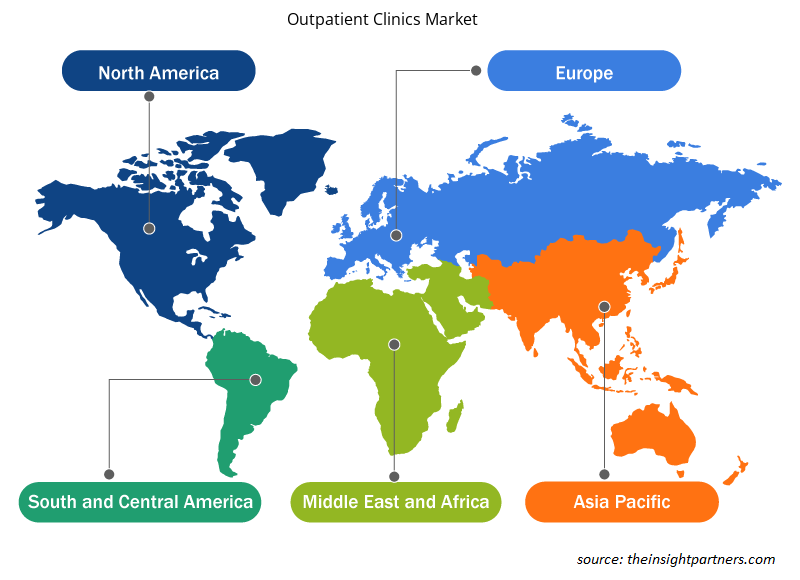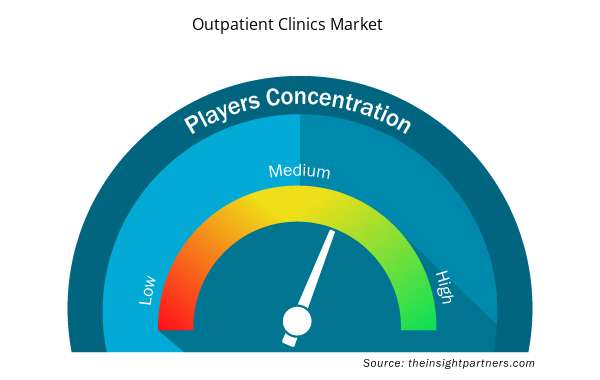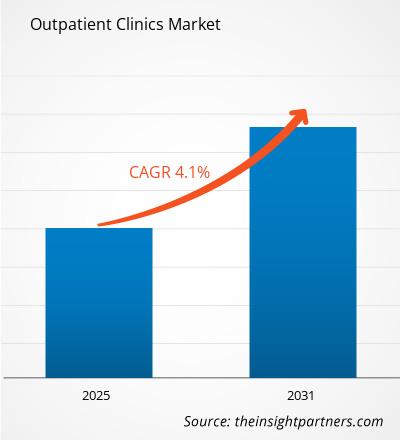Der Markt für Ambulanzen soll von 2023 bis 2031 eine durchschnittliche jährliche Wachstumsrate (CAGR) von 4,1 % verzeichnen, wobei die Marktgröße von XX Millionen US-Dollar im Jahr 2023 auf XX Millionen US-Dollar im Jahr 2031 anwachsen soll.CAGR of 4.1% from 2023 to 2031, with a market size expanding from US$ XX million in 2023 to US$ XX Million by 2031.
Der Bericht ist segmentiert nach Zentrumstyp (Zentren mit einer Spezialisierung, Zentren mit mehreren Spezialisierungen); Service (Diagnose, Behandlung, Notfalldienste); Fachgebiete (Kardiologie, Orthopädie, Gastroenterologie, Zahnmedizin, Augenheilkunde, Urologie, Neurologie, Dermatologie, Sonstige). Der Bericht bietet den Wert in USD für die oben genannte Analyse und Segmente.USD for the above analysis and segments.
Zweck des Berichts
Der Bericht „Markt für ambulante Kliniken“ von The Insight Partners soll die aktuelle Situation und das zukünftige Wachstum sowie die wichtigsten Antriebsfaktoren, Herausforderungen und Chancen beschreiben. Dies wird verschiedenen Geschäftspartnern Einblicke geben, wie zum Beispiel:
- Technologieanbieter/-hersteller: Um die sich entwickelnde Marktdynamik zu verstehen und die potenziellen Wachstumschancen zu kennen, damit sie fundierte strategische Entscheidungen treffen können.
- Investoren: Durchführung einer umfassenden Trendanalyse hinsichtlich der Marktwachstumsrate, der finanziellen Marktprognosen und der Chancen entlang der Wertschöpfungskette.
- Regulierungsbehörden: Zur Regulierung von Richtlinien und Überwachungsaktivitäten auf dem Markt mit dem Ziel, Missbrauch zu minimieren, das Vertrauen der Anleger zu bewahren und die Integrität und Stabilität des Marktes aufrechtzuerhalten.
Ambulanzen Marktsegmentierung
Center-Typ
- Einzelne Spezialzentren
- Multidisziplinäre Zentren
Service
- Diagnose
- Behandlung
- Notdienste
Spezialgebiete
- Kardiologie
- Orthopädie
- Gastroenterologie
- Zahnmedizin
- Augenheilkunde
- Urologie
- Neurologie
- Dermatologie
- Sonstiges
Geographie
- Nordamerika
- Europa
- Asien-Pazifik
- Süd- und Mittelamerika
- Naher Osten und Afrika
Geographie
- Nordamerika
- Europa
- Asien-Pazifik
- Süd- und Mittelamerika
- Naher Osten und Afrika
Passen Sie diesen Bericht Ihren Anforderungen an
Sie erhalten kostenlos individuelle Anpassungen an jedem Bericht, einschließlich Teilen dieses Berichts oder einer Analyse auf Länderebene, eines Excel-Datenpakets sowie tolle Angebote und Rabatte für Start-ups und Universitäten.
- Holen Sie sich die wichtigsten Markttrends aus diesem Bericht.Dieses KOSTENLOSE Beispiel umfasst eine Datenanalyse von Markttrends bis hin zu Schätzungen und Prognosen.
Wachstumstreiber auf dem Markt für ambulante Kliniken
- Steigende Nachfrage nach Vorsorge: Der Markt für ambulante Kliniken erfährt ein steigendes Interesse an Vorsorge, wobei sowohl Patienten als auch Gesundheitssysteme lieber in den frühen Stadien eingreifen, um schlimmere Szenarien zu vermeiden. Dies wird die Bedeutung regelmäßiger Kontrolluntersuchungen, Screenings und Wellnessprogramme erhöhen, was dazu führt, dass mehr Menschen in die ambulanten Kliniken strömen. Kliniken werden aufgrund der gestiegenen Gesundheitskompetenz auch als praktische Optionen für Vorsorgeleistungen wahrgenommen.
- Technologische Fortschritte: Telemedizin und Innovationen im Gesundheitswesen verändern die Art der ambulanten Behandlung, tragen zu einer stärkeren Einbindung der Patienten bei und führen zu einer optimierten Versorgung. Virtuelle Konsultationen und mobile Gesundheitsanwendungen ermöglichen den Zugang zu großen Klinikpopulationen und verbessern die Terminplanung und die Überwachung chronischer Erkrankungen. Der technologische Fortschritt bringt nicht nur mehr betriebliche Effizienz, sondern auch mehr technisch versierte Patienten mit dem Wunsch nach mehr Komfort und maßgeschneiderten Gesundheitslösungen.
- Kosteneffizienz: Ambulante Kliniken sind im Vergleich zur stationären Behandlung billiger, was erstere bei Patienten beliebter macht. Da die Kosten für die Gesundheitsversorgung weiter steigen, suchen Patienten bei der Diagnose und Behandlung nach Kostensenkungsmaßnahmen. Ambulante Behandlungseinrichtungen haben die Kostenbelastung sowohl für den Patienten als auch für den Versicherer im Allgemeinen verringert, was diese Einrichtungen sehr rentabel macht. Dieser aktuelle Trend trägt weiter zu den tatsächlichen Ergebnissen bei, wenn es darum geht, die Patientenergebnisse gegenüber dem Leistungsvolumen hervorzuheben.
Zukünftige Trends auf dem Markt für ambulante Kliniken
- Aufstieg der Telemedizindienste: Die Telemedizin gestaltet die Ambulanzen um; eine davon ist die direkte Behandlung von Patienten von zu Hause aus. Die Technologie für die Erbringung von Gesundheitsdienstleistungen schreitet voran, indem virtuelle Konsultationen durchgeführt werden und mehr Menschen betreut und stärker mit ihnen interagiert wird. Die Telemedizin erkennt die erforderliche zugängliche Gesundheitsversorgung an und verwaltet Ressourcen gut, wodurch der allgemeine Betrieb der Organisation verbessert wird.
- Integration der psychischen Gesundheit: Die Integration der Erbringung von Dienstleistungen im Bereich der psychischen Gesundheit wird in Ambulanzen immer üblicher und ermöglicht einen ganzheitlichen Ansatz in der Patientenversorgung. Heutzutage sind sich die Kliniken ihrer Verbindung zur psychischen Gesundheit sowie der Integrationsrolle von Fachkräften für psychische Gesundheit im Klinikumfeld stärker bewusst. Dieser Dienst entspricht somit dem zunehmenden Trend, psychologische Hilfe in Anspruch zu nehmen, und stellt somit sicher, dass eine umfassende Versorgung gewährleistet ist, während die Ergebnisse der Patienten verbessert werden und das mit der Suche nach Hilfe verbundene Stigma gering bleibt.
- Fokus auf patientenzentrierte Versorgung: In den Ambulanzen wird der Schwerpunkt auf patientenzentrierte Versorgung gelegt, wobei personalisierte Behandlungspläne und eine verbesserte Patientenerfahrung im Vordergrund stehen. Die Meinung der Patienten zu den Dienstleistungen und ihre Teilnahme an diesen Dienstleistungen stehen stärker im Mittelpunkt, was zu einer bedarfsgerechten Leistungserbringung führt. Ein solcher Trend steigert die Kundenzufriedenheit, schafft eine langfristige Beziehung und führt letztendlich zu besseren Gesundheitsergebnissen und Kliniktreue.
Marktchancen für Ambulanzen
- Erweiterung des Serviceangebots: Ambulanzen können ihr Leistungsangebot erweitern, indem sie spezialisierte Behandlungszentren wie Orthopädie, Kardiologie oder Dermatologie einrichten. So können die Kliniken neue Patientengruppen ansprechen und ihre Wettbewerbsfähigkeit steigern. Für eine Klinik bedeutet dies ein Umsatzwachstum, das sich auszahlt und sie zu einem Komplettanbieter im Gesundheitswesen in der Region macht.
- Kooperationen mit Technologieunternehmen: Eine gute Kooperation zwischen einer Ambulanz und einem Technologieunternehmen kann die Bereitstellung von Dienstleistungen deutlich spannender machen. Moderne Telemedizinsysteme, Patientenmanagementsysteme und tragbare Gesundheitstechnologien werden in Kliniken integriert, um eine stärkere Einbindung der Patienten sowie optimierte Abläufe innerhalb der Kliniken zu ermöglichen. Die Möglichkeiten, die solche Unternehmen in solchen Partnerschaften bieten, werden sicherstellen, dass Kliniken in diesem sich schnell verändernden Gesundheitsumfeld angemessen ausgestattet und gut aufgestellt sind, um neuartige, nahtlose Dienstleistungen bereitzustellen.
- Gesundheitsinitiativen der Gemeinschaft: Ambulanzen können sich an Gesundheitsinitiativen der Gemeinschaft beteiligen, um ihre Präsenz zu stärken und Vertrauen bei ihrem lokalen Publikum aufzubauen. Ambulanzen können an Gesundheitsmessen teilnehmen, kostenlose Vorsorgeuntersuchungen anbieten oder Bildungsworkshops veranstalten und so die Aufmerksamkeit der Gemeinschaft auf die verfügbaren Dienste lenken. Diese Initiativen fördern den guten Willen und ziehen Patientenempfehlungen sowie Sichtbarkeit für die Klinik an.
Regionale Einblicke in den Markt für Ambulanzen
Die regionalen Trends und Faktoren, die den Markt für Ambulanzen im Prognosezeitraum beeinflussen, wurden von den Analysten von Insight Partners ausführlich erläutert. In diesem Abschnitt werden auch Marktsegmente und Geografie für Ambulanzen in Nordamerika, Europa, im asiatisch-pazifischen Raum, im Nahen Osten und Afrika sowie in Süd- und Mittelamerika erörtert.

- Erhalten Sie regionale Daten zum Markt für Ambulanzen
Umfang des Marktberichts für ambulante Kliniken
| Berichtsattribut | Details |
|---|---|
| Marktgröße im Jahr 2023 | XX Millionen US-Dollar |
| Marktgröße bis 2031 | XX Millionen US-Dollar |
| Globale CAGR (2023 - 2031) | 4,1 % |
| Historische Daten | 2021-2022 |
| Prognosezeitraum | 2024–2031 |
| Abgedeckte Segmente | Nach Centertyp
|
| Abgedeckte Regionen und Länder | Nordamerika
|
| Marktführer und wichtige Unternehmensprofile |
|
Dichte der Marktteilnehmer im Bereich Ambulanzen: Auswirkungen auf die Geschäftsdynamik verstehen
Der Markt für ambulante Kliniken wächst rasant, angetrieben durch die steigende Nachfrage der Endnutzer aufgrund von Faktoren wie sich entwickelnden Verbraucherpräferenzen, technologischen Fortschritten und einem größeren Bewusstsein für die Vorteile des Produkts. Mit steigender Nachfrage erweitern Unternehmen ihr Angebot, entwickeln Innovationen, um die Bedürfnisse der Verbraucher zu erfüllen, und nutzen neue Trends, was das Marktwachstum weiter ankurbelt.
Die Marktteilnehmerdichte bezieht sich auf die Verteilung der Firmen oder Unternehmen, die in einem bestimmten Markt oder einer bestimmten Branche tätig sind. Sie gibt an, wie viele Wettbewerber (Marktteilnehmer) in einem bestimmten Marktraum im Verhältnis zu seiner Größe oder seinem gesamten Marktwert präsent sind.
Die wichtigsten auf dem Markt für Ambulanzen tätigen Unternehmen sind:
- Cigna
- Mayo-Stiftung für medizinische Ausbildung und Forschung
- Kaiser Foundation Health Plan, Inc
- Cleveland-Klinik
- Vanguard Healthcare-Lösungen
Haftungsausschluss : Die oben aufgeführten Unternehmen sind nicht in einer bestimmten Reihenfolge aufgeführt.

- Überblick über die wichtigsten Akteure auf dem Markt für ambulante Kliniken
Wichtige Verkaufsargumente
- Umfassende Abdeckung: Der Bericht deckt die Analyse von Produkten, Dienstleistungen, Typen und Endbenutzern des Marktes für ambulante Kliniken umfassend ab und bietet einen ganzheitlichen Überblick.
- Expertenanalyse: Der Bericht basiert auf dem umfassenden Verständnis von Branchenexperten und Analysten.
- Aktuelle Informationen: Der Bericht stellt durch die Abdeckung aktueller Informationen und Datentrends Geschäftsrelevanz sicher.
- Anpassungsoptionen: Dieser Bericht kann angepasst werden, um spezifische Kundenanforderungen zu erfüllen und die Geschäftsstrategien optimal anzupassen.
Der Forschungsbericht zum Markt für Ambulanzen kann daher dabei helfen, die Branchensituation und Wachstumsaussichten zu entschlüsseln und zu verstehen. Obwohl es einige berechtigte Bedenken geben kann, überwiegen die allgemeinen Vorteile dieses Berichts tendenziell die Nachteile.
- Historische Analyse (2 Jahre), Basisjahr, Prognose (7 Jahre) mit CAGR
- PEST- und SWOT-Analyse
- Marktgröße Wert/Volumen – Global, Regional, Land
- Branche und Wettbewerbsumfeld
- Excel-Datensatz



Report Coverage
Revenue forecast, Company Analysis, Industry landscape, Growth factors, and Trends

Segment Covered
This text is related
to segments covered.

Regional Scope
North America, Europe, Asia Pacific, Middle East & Africa, South & Central America

Country Scope
This text is related
to country scope.
Häufig gestellte Fragen
The Multi-Specialty Centers segment accounts for highest revenue in center type sgement in 2023
Cigna, Mayo Foundation for Medical Education and Research, Kaiser Foundation Health Plan, Inc, Cleveland Clinic, Vanguard Healthcare Solutions, FastHealth Corporation, Southwest Behavioral & Health Services, DaVita Inc, Fresenius Medical Care AG & Co. KGaA, The Johns Hopkins Hospital are some of the major market players operating in the market
Asia Pacific region dominated the outpatient clinics market in 2023
North America region dominated the outpatient clinics market in 2023
The major factors driving the outpatient clinics market are:
1.Increasing Demand for Preventive Care
2. Technological Advancements
3. Cost-Effectiveness
The Outpatient Clinics Market is estimated to witness a CAGR of 4.1% from 2023 to 2031
Trends and growth analysis reports related to Life Sciences : READ MORE..
1. Cigna2. Mayo Foundation for Medical Education and Research3. Kaiser Foundation Health Plan, Inc4. Cleveland Clinic5. Vanguard Healthcare Solutions6. FastHealth Corporation7. Southwest Behavioral and Health Services8. Davita Inc9. Fresenius Medical Care AG and Co. KGaA10. The Johns Hopkins Hospital
The Insight Partners performs research in 4 major stages: Data Collection & Secondary Research, Primary Research, Data Analysis and Data Triangulation & Final Review.
- Data Collection and Secondary Research:
As a market research and consulting firm operating from a decade, we have published and advised several client across the globe. First step for any study will start with an assessment of currently available data and insights from existing reports. Further, historical and current market information is collected from Investor Presentations, Annual Reports, SEC Filings, etc., and other information related to company’s performance and market positioning are gathered from Paid Databases (Factiva, Hoovers, and Reuters) and various other publications available in public domain.
Several associations trade associates, technical forums, institutes, societies and organization are accessed to gain technical as well as market related insights through their publications such as research papers, blogs and press releases related to the studies are referred to get cues about the market. Further, white papers, journals, magazines, and other news articles published in last 3 years are scrutinized and analyzed to understand the current market trends.
- Primary Research:
The primarily interview analysis comprise of data obtained from industry participants interview and answers to survey questions gathered by in-house primary team.
For primary research, interviews are conducted with industry experts/CEOs/Marketing Managers/VPs/Subject Matter Experts from both demand and supply side to get a 360-degree view of the market. The primary team conducts several interviews based on the complexity of the markets to understand the various market trends and dynamics which makes research more credible and precise.
A typical research interview fulfils the following functions:
- Provides first-hand information on the market size, market trends, growth trends, competitive landscape, and outlook
- Validates and strengthens in-house secondary research findings
- Develops the analysis team’s expertise and market understanding
Primary research involves email interactions and telephone interviews for each market, category, segment, and sub-segment across geographies. The participants who typically take part in such a process include, but are not limited to:
- Industry participants: VPs, business development managers, market intelligence managers and national sales managers
- Outside experts: Valuation experts, research analysts and key opinion leaders specializing in the electronics and semiconductor industry.
Below is the breakup of our primary respondents by company, designation, and region:

Once we receive the confirmation from primary research sources or primary respondents, we finalize the base year market estimation and forecast the data as per the macroeconomic and microeconomic factors assessed during data collection.
- Data Analysis:
Once data is validated through both secondary as well as primary respondents, we finalize the market estimations by hypothesis formulation and factor analysis at regional and country level.
- Macro-Economic Factor Analysis:
We analyse macroeconomic indicators such the gross domestic product (GDP), increase in the demand for goods and services across industries, technological advancement, regional economic growth, governmental policies, the influence of COVID-19, PEST analysis, and other aspects. This analysis aids in setting benchmarks for various nations/regions and approximating market splits. Additionally, the general trend of the aforementioned components aid in determining the market's development possibilities.
- Country Level Data:
Various factors that are especially aligned to the country are taken into account to determine the market size for a certain area and country, including the presence of vendors, such as headquarters and offices, the country's GDP, demand patterns, and industry growth. To comprehend the market dynamics for the nation, a number of growth variables, inhibitors, application areas, and current market trends are researched. The aforementioned elements aid in determining the country's overall market's growth potential.
- Company Profile:
The “Table of Contents” is formulated by listing and analyzing more than 25 - 30 companies operating in the market ecosystem across geographies. However, we profile only 10 companies as a standard practice in our syndicate reports. These 10 companies comprise leading, emerging, and regional players. Nonetheless, our analysis is not restricted to the 10 listed companies, we also analyze other companies present in the market to develop a holistic view and understand the prevailing trends. The “Company Profiles” section in the report covers key facts, business description, products & services, financial information, SWOT analysis, and key developments. The financial information presented is extracted from the annual reports and official documents of the publicly listed companies. Upon collecting the information for the sections of respective companies, we verify them via various primary sources and then compile the data in respective company profiles. The company level information helps us in deriving the base number as well as in forecasting the market size.
- Developing Base Number:
Aggregation of sales statistics (2020-2022) and macro-economic factor, and other secondary and primary research insights are utilized to arrive at base number and related market shares for 2022. The data gaps are identified in this step and relevant market data is analyzed, collected from paid primary interviews or databases. On finalizing the base year market size, forecasts are developed on the basis of macro-economic, industry and market growth factors and company level analysis.
- Data Triangulation and Final Review:
The market findings and base year market size calculations are validated from supply as well as demand side. Demand side validations are based on macro-economic factor analysis and benchmarks for respective regions and countries. In case of supply side validations, revenues of major companies are estimated (in case not available) based on industry benchmark, approximate number of employees, product portfolio, and primary interviews revenues are gathered. Further revenue from target product/service segment is assessed to avoid overshooting of market statistics. In case of heavy deviations between supply and demand side values, all thes steps are repeated to achieve synchronization.
We follow an iterative model, wherein we share our research findings with Subject Matter Experts (SME’s) and Key Opinion Leaders (KOLs) until consensus view of the market is not formulated – this model negates any drastic deviation in the opinions of experts. Only validated and universally acceptable research findings are quoted in our reports.
We have important check points that we use to validate our research findings – which we call – data triangulation, where we validate the information, we generate from secondary sources with primary interviews and then we re-validate with our internal data bases and Subject matter experts. This comprehensive model enables us to deliver high quality, reliable data in shortest possible time.


 Holen Sie sich ein kostenloses Muster für diesen Bericht
Holen Sie sich ein kostenloses Muster für diesen Bericht